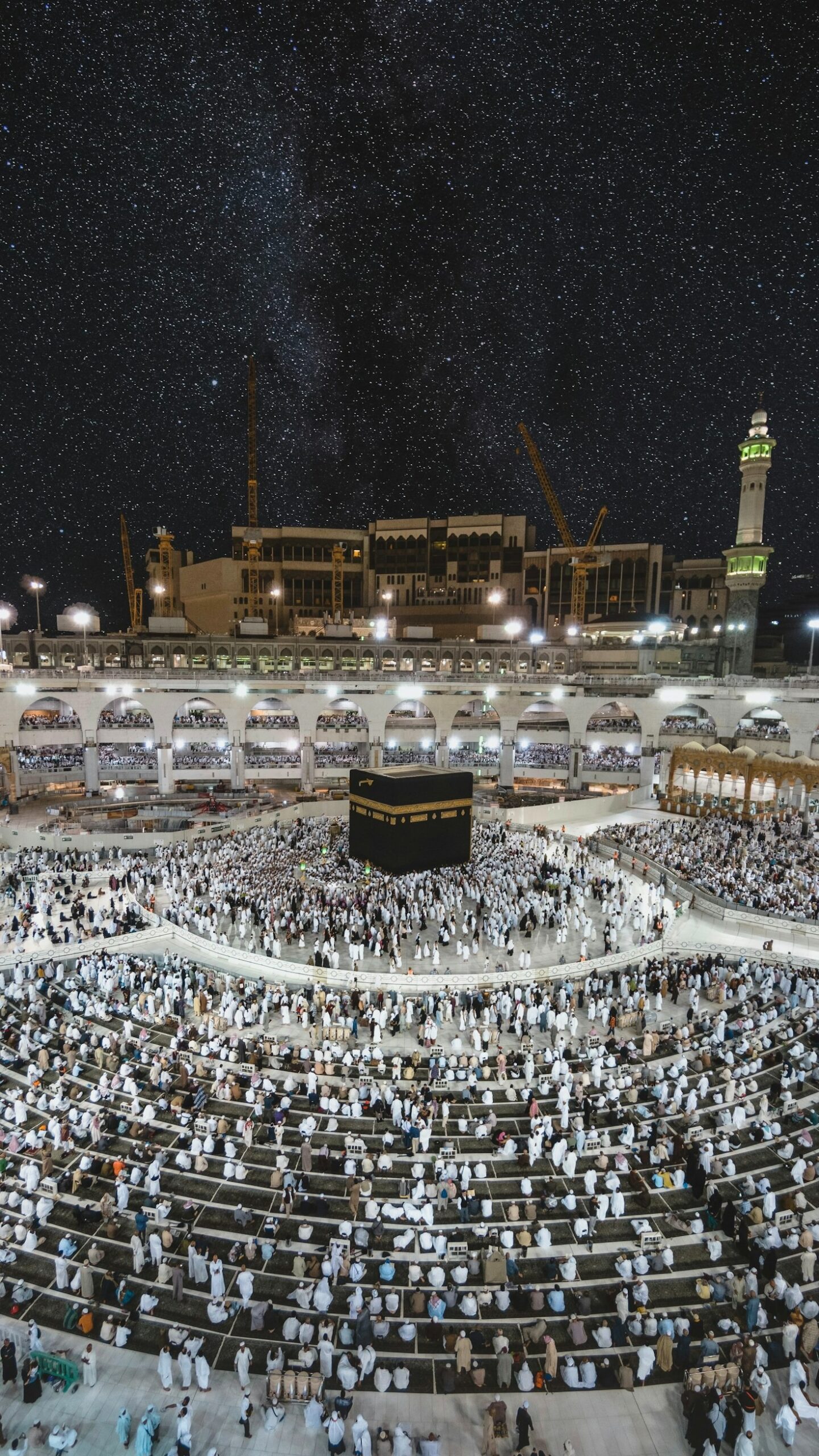- What is the Hajj?
The Hajj represents the yearly pilgrimage to Mecca, located in Saudi Arabia, and constitutes the fifth and final pillar of Islam, alongside the declaration of faith (shahada), the five daily prayers, obligatory charity (zakat), and fasting during Ramadan.
The term derives from the Arabic root “h-j-j”, which translates to “intending a journey” or “to embark on a specific purpose”.
It is mandated that every adult Muslim who is physically and financially capable must undertake this journey at least once in their lifetime.
- When is the Hajj performed?
The Hajj occurs between the 8th and 12th (or 13th) of Dhul-Hijjah, the twelfth and final month of the Islamic calendar. This period is approximately 70 days following the conclusion of Ramadan, although slight variations may occur due to the lunar cycle.
In 2025, the Hajj is scheduled from June 4 to June 9, with many pilgrims arriving in the preceding days and weeks to prepare for the journey.
Due to the Islamic calendar’s reliance on the lunar cycle, with months lasting either 29 or 30 days, the Hajj occurs 10 to 12 days earlier each year in the Gregorian calendar. Significantly, this year will be the last time in the next 16 years that the Hajj coincides with the peak summer heat in Mecca.
- Why do Muslims perform the Hajj?
Muslims regard the Hajj as a direct command from Allah (God), as stated in the Quran, the holy book of Islam.
This was confirmed during Prophet Muhammad’s “farewell pilgrimage” in 632 AD, which was the 10th year of the Islamic calendar.
According to Islamic tradition, the Kaaba, a stone edifice covered in black silk situated at the center of Mecca’s Grand Mosque where numerous Hajj rituals are conducted, was constructed by Prophet Abraham (Ibrahim) and his son Ishmael (Ismaeel) under divine instruction. This event signifies the inception of the Hajj, which was established as a sacred ritual for the first time.


4. How long does the Hajj last?
The Hajj lasts five to six days, depending on how it is performed. It begins on the 8th of Dhul-Hijjah, a day known as Tarwiyah, when many pilgrims travel to Mina, a desert valley located about 8 kilometres (5 miles) from Mecca, where they spend the night in preparation for the next day’s rituals.
It ends with Tashreeq days, where pilgrims return to Mina for the symbolic stoning of the Devil at a site called Jamarat, after which they perform final rituals to symbolise the end of the Hajj. Some may leave on the 12th if they complete their rites early, while others stay until the 13th.
5. What is the difference between the Hajj and Umrah?
While the Hajj is a compulsory pilgrimage for all able-bodied Muslims once in their life, Umrah is a recommended smaller and simpler pilgrimage that Muslims can perform any time throughout the year.
The graphic below shows some of the key differences between the Hajj and Umrah:
The pilgrimage is fundamentally a spiritual endeavor, regarded as a means for Muslims to seek forgiveness, cleanse their souls, and exhibit their submission to God. The term Hajj appears 12 times throughout the Quran, including a chapter that bears its name.
Additionally, Hajj acts as a poignant reminder of the Day of Judgement, and through its observance, Muslims emulate the example set by Prophet Abraham and his family, whose deeds are honored during the pilgrimage rituals. Ultimately, it serves as a means to fulfill a significant religious duty and reinforce one’s faith.
What are the principal rituals that Muslims engage in during the Hajj?
During the Hajj, Muslims partake in numerous rites and rituals, which can be delineated in the following sequence.
DAY 1
Ihram – Entering the state of Ihram represents both a physical and spiritual condition, encompassing the niyah or intention to undertake the Hajj, donning specific garments (two unstitched pieces of cloth for men and modest clothing for women), and adhering to established conduct. This ritual must be performed prior to entering Mecca, either in the pilgrim’s home country or at one of the designated sites on the outskirts of Mecca.
Arrival Tawaf – Upon entering Mecca in Ihram, many pilgrims engage in an initial Tawaf by circling the Kaaba seven times in a counterclockwise manner. This act symbolizes unity in the worship of the One God. Subsequently, pilgrims may perform the sa’i, a ritual involving the act of walking seven times between the hills of Safa and Marwa, situated within the Masjid al-Haram.
Mina – Pilgrims then proceed to Mina, located approximately 8km (5 miles) east of the Kaaba, where they will spend the night in prayer and contemplation. Mina is famously referred to as the “city of tents” due to the extensive array of white tents that accommodate the millions of pilgrims.
The pilgrimage is fundamentally a spiritual endeavor, regarded as a means for Muslims to seek forgiveness, cleanse their souls, and exhibit their submission to God. The term Hajj appears 12 times throughout the Quran, including a chapter that bears its name.
Additionally, Hajj acts as a poignant reminder of the Day of Judgement, and through its observance, Muslims emulate the example set by Prophet Abraham and his family, whose deeds are honored during the pilgrimage rituals. Ultimately, it serves as a means to fulfill a significant religious duty and reinforce one’s faith.
What are the principal rituals that Muslims engage in during the Hajj?
During the Hajj, Muslims partake in numerous rites and rituals, which can be delineated in the following sequence.
DAY 1
Ihram – Entering the state of Ihram represents both a physical and spiritual condition, encompassing the niyah or intention to undertake the Hajj, donning specific garments (two unstitched pieces of cloth for men and modest clothing for women), and adhering to established conduct. This ritual must be performed prior to entering Mecca, either in the pilgrim’s home country or at one of the designated sites on the outskirts of Mecca.
Arrival Tawaf – Upon entering Mecca in Ihram, many pilgrims engage in an initial Tawaf by circling the Kaaba seven times in a counterclockwise manner. This act symbolizes unity in the worship of the One God. Subsequently, pilgrims may perform the sa’i, a ritual involving the act of walking seven times between the hills of Safa and Marwa, situated within the Masjid al-Haram.
Mina – Pilgrims then proceed to Mina, located approximately 8km (5 miles) east of the Kaaba, where they will spend the night in prayer and contemplation. Mina is famously referred to as the “city of tents” due to the extensive array of white tents that accommodate the millions of pilgrims.
7. What are the different types of Hajj?
There are three types of Hajj to facilitate the pilgrimage for Muslims from different locations and abilities:
8. What is not permitted during the Hajj?
The etiquette of the Hajj bans several actions that are otherwise permitted in Islam, including sexual relations (and anything leading to it, like embracing or kissing), cursing, arguing, hunting, shaving or cutting hair and nails, using perfume, arranging or conducting a marriage, wearing stitched clothes (for men), covering the head (for men), and covering the face (for women).
Hajj al-Tamattu (the “eased” Hajj) – This type of Hajj is the most prevalent, especially among international pilgrims or those residing outside of Mecca. In this variant, pilgrims initially perform Umrah, exit the state of Ihram, and subsequently re-enter Ihram to undertake Hajj. For individuals engaging in Hajj al-Tamattu, the sacrifice of an animal is mandatory, unless they are unable to afford it, in which case fasting is required instead.
Hajj al-Qiran (The “combined” Hajj) – In the case of Hajj al-Qiran, pilgrims merge Umrah and Hajj, akin to Tamattu, but do not exit the state of Ihram. Throughout both rites, pilgrims remain in Ihram. The sacrifice of an animal is also obligatory for those who have the means to do so.
Hajj al-Ifrad (Hajj alone) – Hajj al-Ifrad is designated for pilgrims who perform Hajj independently, without the combination of Umrah. This form is typically undertaken by residents of Mecca. Notably, this variant of Hajj does not necessitate the sacrifice of an animal, although it may be performed voluntarily.
In instances where a pilgrim inadvertently or unknowingly commits a prohibited act during Hajj, there are generally specific measures and actions to amend their situation. This typically includes repentance, along with compensating for the error by providing charity or an animal sacrifice.
- What should one pack for the Hajj? Packing for the Hajj necessitates meticulous planning to ensure that all essential items are included without excessive burden. The accompanying graphic offers a practical checklist of items one should prepare prior to commencing the journey.
Eid al-Adha also encompasses the ritual of animal sacrifice, Referred to as Qurbani, Muslims who possess the means to do so sacrifice a sheep, goat, cow, or camel. The meat is then distributed into three portions: one for the family, one for relatives and friends, and one for those in need.

